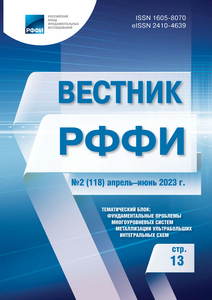Vestnik Rossijskij fond fundamentalʹnyh issledovanij
ISSN (print): 1605-8070, ISSN (online): 2410-4639
Media registration certificate: 012620 from 03.06.1994, ЭЛ № ФС 77 – 61404 from 10.04.2015
Founder: Russian Foundation for Basic Research
Editor-in-Chief: Panchenko Vladislav Yakovlevich, academician RAS, Doctor of Sc., Full Professor
Frequency / Assess: 4 issues per year / Open
Included in: Higher Attestation Commission list, RISC
Current Issue
Vol 113, No 1 (2022): Digital transformation of secondary school
- Year: 2022
- Articles: 12
- URL: https://ogarev-online.ru/1605-8070/issue/view/19777
-
Description:
Readers are invited to the Russian Foundation for Basic Research Journal issue, dedicated to the most urgent task of modern pedagogy – the digitalization of secondary education. In our country in the mid-1980s, with a lead compared to other countries, mass work on the digital transformation of school education began. However, the results of this work were noticeable mainly in the emergence and development of the school computer science course.
Full Issue
THEMED ISSUE EDITOR’S COLUMN
About the Editor of the Themed Section
Abstract
Alexei Semenov was born in 1950 in a family of engineers. After graduating from Moscow School No. 7, then he studied at Moscow State University at the Department of Mechanics and Mathematics and then at graduate school at the Department of Mathematical Logic. In 1975 by defending his dissertation “On definability in some decidable theories” he became Candidate of Physical and Mathematical Sciences.
 6-8
6-8


Abstract of the Themed Section
Abstract
Readers are invited to the Russian Foundation for Basic Research Journal issue, dedicated to the most urgent task of modern pedagogy – the digitalization of secondary education. In our country in the mid-1980s, with a lead compared to other countries, mass work on the digital transformation of school education began. However, the results of this work were noticeable mainly in the emergence and development of the school computer science course.
 9-19
9-19


Fundamental foundations of the Digital School Transformation program (School Digital Path Charter). Summary.
Abstract
Образование должно опираться на задатки, способности и стремления каждого ребенка: узнавать и создавать новое, общаться, сотрудничать, учиться и учить. Актуализация и развитие этого человеческого потенциала с учетом личностных и когнитивных черт каждого ребенка – всё бóльшая необходимость. В мире ускоряющихся непредсказуемых и необратимых изменений формируются пути становления опережающего, преадаптивного образования.
Мы не можем оставаться в стороне и ждать.
Мы должны не догонять, а опережать события
 20-22
20-22


THEMED SECTION: FUNDAMENTAL SCIENTIFIC RESEARCH IN THE FIELD OF NATURAL SCIENCES
What Is the Education Becoming?
Abstract
Education should be based on the inclinations, abilities and aspirations of each child: to learn and create new things, to communicate, cooperate, learn and teach. The actualization and development of this human potential, considering the personal and cognitive traits of each child, is an ever-greater need. In the world of accelerating, unpredictable and irreversible changes the ways of becoming an advanced, pre-adaptive education are being formed.
We cannot stand by and wait.
We must not catch up but get ahead of events.
 23-37
23-37


Digitally Enhanced Personality
Abstract
The evolution of mankind is based on the expansion of the capabilities of Homo sapiens based on the development and mastery of technology as cultural tools for development. A letter and a book are prime examples. Today the human personality has been expanded not only with a pen, a watch, a spyglass and an encyclopedia but also with a calculator, an automatic translator, a digital navigator, access to the World Wide Web and other digital means of expanding the mind which tremendously increase the power of the human brain. We evaluate graduates in terms of their ability to engage in cognitive, labor, and other activities as an extended personality who masters digital means and is able to make a moral choice in a digital society. The system of educational goals, planned results, standards, programs should be addressed specifically to the extended personality of the student and teacher
 38-51
38-51


he Right of a Child to the Digital World
Abstract
Through a tablet with Internet access a child has at his disposal the wealth and misfortune of all mankind, cultural tools of activity, communication and education, his rights and responsibilities in the digital world. The digital world expands the possibilities for choice, opens new ways to try and grow up. It poses the problem of choice and responsibility to adults whose decisions influence the fate of the child.
Among teachers and parents there will always be those who want to make a choice for the child, protecting him from the real or imaginary dangers of the digital and non-digital world. Today, at the choice of parents, there should be schools where gadgets are prohibited, children go to all classes and online presence is only due to illness.
 52-59
52-59


School and Teacher
Abstract
Today the school is digitally extended beyond the school building to the universe; a school is a ship, a workshop, a factory, a laboratory, a theatre, a museum, a forest and an ocean. The purpose of the school and the teacher is to give the student motivation for active life and learning, help him organize his activities and cooperate with peers and significant adults, ensure the preservation and promotion of health, equalize the opportunities for quality education for all, give chances for a decent future for children with disabilities health and their families.
Using and developing all the abilities and possibilities of his extended personality the teacher learns together with the students, gives feedback and, most importantly, motivates and captivates the students. We must not catch up but get ahead of events.
 60-69
60-69


The Content of Education
Abstract
The student is a co-author of education that expands the possibilities for the development of his personality. He independently and with the support of a teacher not only repeats the path of mankind but also discovers the laws of nature, society and personality, invents methods and algorithms, realizes big ideas – the basis for his orientation in he world. He masters emerging cultural practices and participates in their creation.
Knowledge, skills and life skills will be possessed by the expanded personality of the student. In the future, the need for “memorization” and the time spent on achieving dexterity in work will be greatly reduced. Readiness for perception and creation of a new, independent search and application of knowledge and mode of action are the basis for creative development and pre-adaptation of the individual. The laws and algorithms independently discovered by the student, the facts found are preserved by him in the expanded developing personality and are used as cultural tools. The school develops systemic and critical thinking, universal actions and digital skills for the 21st century, helps the child to choose and master from the treasures of human culture what he likes, whether it is calligraphy, programming, acrobatics or versification.
 70-86
70-86


Digital Education Platform
Abstract
Today there are different understandings of what is considered part of a digital platform, what is on it and what is available through it. A digital integrated implementation of the following functions is required, regardless of how we define their relationship with the platform:
— support for group communication with the ability to record the process;
— accounting for the roles of the student, teacher, administrator, parent; automatic generation of digital journals and report cards;
— formation of the history of individual work and recording of educational events of the student, teacher, class; including it in the big data of education;
— designing an individual path for students to achieve educational goals with a choice of those posted on the platform; selection and implementation of tasks offered by the teacher;
— placement the goals, assignments, feedback and assessment tools, other learning materials;
— accommodating student learning requests and suggestions from teachers, organizations, and educational programs that go beyond the boundaries of one school;
— recording learning outcomes; displaying and forecasting on the basis of big data of the educational process with varying level of detail.
The digital platform helps the teacher get rid of routine reporting. It opens up new possibilities for pedagogy of dignity and cooperation.
 87-103
87-103


Results and Evaluation
Abstract
The educational community and the whole society are moving away from examination and test procedures. The strengths and significant deficiencies of a person are identified on a digital platform in the process of education and application of its results. They become the basis for decision-making by an educational organization or employer. This does not exclude the possibility of demonstrating the highest achievement in an exam or educational contests which may be the main argument in promoting a person.
 104-113
104-113


Parents, Upbringing, Safety, Morality and Ethics of the Digital World
Abstract
In the digital world many adults see only new risks for children and parents. But new opportunities for mutual understanding, rapprochement and cooperation in the family are constantly being formed in it.The adults’ task is to help the child form an idea of the visibility of all actions and their preservation in the digital environment. And at the same time the task is to form the imperative of the significance and inviolability of the personality of the other, the protection of oneself from invasion, the possibility of repentance and forgiveness. The principles of digital morality, ethics and law relating to the preservation and use of information have not yet been created but are increasingly needed.
The development of destructive digital addictions, violations of the higher mental functions of the child must be prevented by involving children in real life which implies the harmony of the child with the virtual and real world.
 114-121
114-121


Creators of the New in Education
Abstract
It is impossible to predict the future of education. It can be jointly created based on the emerging humanitarian, communication technologies and other achievements of modern civilization. 440 years after the great Jan Comenius, we are taking the next step by creating a new science of learning: digital mathetics and digital didactics. The authors of textbook with the connections to digital means aimed at mastering human activity and university professors start from the experience of their childhood are based on the achievements of mankind, realize and form the possibilities and needs of the future in the present. Science gets the opportunity to study the accelerating evolution of education and analyze big data displayed in a variety of digital platforms. The global educational community is becoming a source of experience for critical decisions and direct pedagogical interaction. Geographical and language barriers are easing. Leaders of society, state and business get the opportunity to realize their vision in a specific project and digital technologies open access to participate in the project to everyone who supports the humanistic idea in our transforming world
 122-133
122-133











